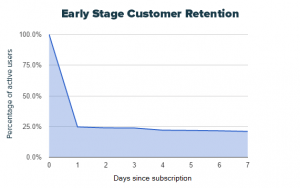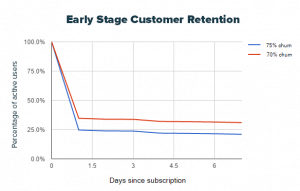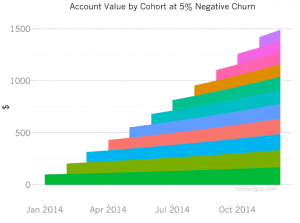Customer retention is like dating.
You don’t interact with your significant other the same way on your first date as you do on your 50th or 200th date. Similarly, giving a customer a great experience on day one isn’t going to be the same as on day 50. In order to boost retention numbers and make this relationship last, it is important to address the problems specific to the user’s journey.
First, let’s address the relationship stages. Your customer goes through three phases with your product:
- The get-to-know-me phase. Think of this as the first date for new users. First impressions are everything, so you want to make sure you show them what you’re all about without overwhelming them.
- The casual dating phase. These are the seasoned users who are pretty familiar with your app. They are content with the experience and have started forming habits around it.
- The serious dating phase. These are the power users. They’re serious about your app and can’t live without it. This involves the user using the app for its maximum capabilities and telling all their friends about it.
Each phase requires a different type of retention strategy. Adjusting your onboarding walkthrough isn’t going to keep users who have been using the product for eight months from churning. Just like how improving the stickiness of your features isn’t going to improve a user’s first experience with your app.
Here’s my breakdown of the three stages of customer retention and how you can address churn at each stage.
New Users (0-7 days)
The purpose of early-stage retention is to get a user to use your app more than once. This is one of the most important parts of the customer journey because it determines how much of a customer base sticks around for the next two stages. Your job is to get as many customers to have a great first impression as possible, so that you have an opportunity to win them over for the long haul later.
So say this is a graph of your app’s early retention rate:
Within just one day, you lose 75% of users. At first glance, this is catastrophic, but hidden in this graph is good news too. The users who did make it past one day seem to continue using the product. That means you have to fix something about your first-time user experience. Let’s say, you fix some of your in-app onboarding cues, and manage to lift your retention by 5%.
This looks like just a slight lift, but a lift of 5% in your customer retention can mean up to a 25% revenue increase. Big companies would kill for a profit increase of that size, so improve your early-stage retention early on, and you’ll get that high revenue while you still have a relatively small user base.
Improve user onboarding
The best way to improve your early-stage retention is to improve your user onboarding experience. According to Basecamp CEO Jason Fried, your onboarding should focus on “here’s what you can do with our product,” rather than “here’s what our product can do.” The first is user-centric, the second is product-centric.
To create a user-centric experience, your goal is to create Aha! moments—the moment where they “get” why your app is so useful— for the most users as early on as possible. Here’s how:
- Form an informed hypothesis based on existing data. Look at behavioural analytics of long-time customers to glean what the most popular features and use cases of your app are, and make several estimations as to where your users experience Aha! moments.
- A/B test different features to test hypotheses. Create several onboarding workflows that emphasize different features of your app and see which ones get users to use the app a second and third time.
- Survey after onboarding. The Aha! moment is an elusive thing to nail down, so the best way to work your onboarding around it is to learn when successful customers reached theirs. You might have been leading only the most patient users to find their Aha! moment, instead of pointing all users to your stickiest feature sooner.
While your product’s core value might be obvious to you, you can’t just go out and claim that it’ll make your users lives’ better. You have to lead them to that conclusion on their own.
Seasoned Users (8-90 days)
During the middle-stage retention period, users get to know your product on a whole new level, digging through all the features and possible use cases. You can’t control everything in your app, but you can work to pinpoint friction and eliminate it.
You might look at an acquisition cohort analysis and see a steady decrease in retention month to month. But a steady decrease in active users—as shown in the graph below—doesn’t give you any indication as to where users are losing interest.
The unsexy truth is that churn is a lagging indicator—especially in the middle-retention period. A user might have used your app three times in the first week, but never made it a habit because the login process is too damn difficult. It took a few months of them staring at their cluttered home screen before deciding to unsubscribe from your service. To keep users engaged at this stage, you’ll need to dive deeper than churn.
Look at How Users Spend Their Time
Once you’re plummeting into consistent customer desertion, it’s probably too late to backtrack and convince users to stay. But there are ways to get a better understanding of your users’ behaviours and where they’re encountering friction in your app. Here are the analytics you can look at to help locate pain points before they cause churn.
- Screen visits. See which screens users spend a lot of time on, and which they avoid. This will help you re-evaluate the UI of potentially offputting screens.
- Screen flow. These analytics will show you how many clicks it takes for users to get to the part of the app they use the most. Or, alternatively, whether their behaviour points them to the wrong page at the wrong time (high bounce rates)
- Overall time in app. Users who are spend little or no time in your app haven’t found a lasting value in your product. This might require nudging through re-engagement emails, or bringing in back-up help from sales or customer support.
There are no quick fixes at this stage of the user lifecycle. There’s no dancing around a bad UX, so use all your resources to make sure your users are happy with your product. Use behavioural analytics to make informed product decisions, so that your users can have a better product experience and stay long enough to gain value.
Power Users (91+ days)
Once users are active 90 days or more, they’re reliable users who are happy to continue using your product. Now, your goal is to take those seasoned committed customers and drive them even deeper into your product, transforming them into power users.
You can do this by working to increase customer value over time. That means your users will upgrade, use more products, or even be an advocate for your brand. This will help you work towards achieving negative churn—the most powerful growth weapon according to Tom Tunguz, partner at venture capital firm Redpoint Ventures. This means that your revenue will grow regardless of how many customers you acquire.
Source: tomtunguz.com
In the chart above, each colour is a cohort of users who started at different times. If you constantly work to increase each cohort’s value, they will build on top of each other and considerably increase revenue in the long term. This way, not only do you not need to worry about acquiring customers to survive, but you won’t even need to acquire customers to grow.
Constantly Try to Further Enamour Your Customers
If your customers like your app, you’re off to a good start. But you want your customers to love your app. That transition requires you to offer your users even more value than they had signed up for. They might have thought they were getting a checklist app, but what they actually got was an app that they used for all their communication outreach and kept track of benchmarks and goals.
Here are three ways to give your users more value.
- Upsell wisely. Make recommendations for bigger plans or different products in your platform, but make sure you don’t overdo. The line between friendly suggestion and pestering sales email is very fine. Make it user-centric, and consider easing them into it with a free trial.
- Harness the power of referral. Referral programmes are usually taken advantage of in the B2C world, but that only makes it an even more powerful tool for B2B. Not only do like businesses network with like businesses, but users who refer also tend to feel even more invested in the app they recommended.
- Build for your VIPs. Establish a relationship with the top 20% of users, and get their suggestions for product modifications. They are basically your buyer persona, so not only will they become more valuable as they use your new product, but you’ll drive other users who hadn’t spoken up deeper into your app.
You want your app to achieve long-term success, so you have to strive to create something that your users can’t live without. Give them value, and you’ll get value in return.
Not Easy, but Worth It!
A lot of things have to go right for a relationship to work out, and your relationship with your customers is no exception. There’s no quick band-aid that can make a difference in the long term. Rather, customer retention consists of many, many layers—each of which can determine your success.
Improve your onboarding, and you will have much more users that could grow in value 90 days down the line. But ignore users in their third month of using your app, and don’t be surprised if many of them move to the next hot app on the market. Put in the work to get to know users and identify pain points, and the relationship will be well worth it.












Comments
Join the community
Sign up for free to share your thoughts